The real-world effectiveness of Covid vaccines has not matched the hype of the 95 percent efficacy claimed in manufacturer trials on the basis of which they were granted emergency-use authorisation.
They’ve proven disappointingly leaky with a surprisingly swift waning of effectiveness, necessitating boosters every few months.
In many cases vaccine rollouts coincided with an upsurge in infections, substantiating the concerns expressed by many experts that a mass vaccination campaign in the middle of a pandemic will drive the evolution of vaccine-escape variants and generate self-perpetuating waves of infections from the mutating variants.
A study from Oxford University in June showed the infection risk increased by 44 percent in the double-vaccinated in England. An analysis in July by El Gato Malo showed that US states with higher vaccination rates were experiencing higher Covid hospital admissions. By the end of 2022 the vast majority of Covid deaths in many countries were among the vaccinated and boosted.
This has discredited officials and health experts from President Joe Biden on down who claimed that the vaccines would prevent infection, onward transmission, severe illness and (initially)/or (as a fallback justification) death. Hence their early but by now abandoned claims about the pandemic of the unvaccinated.
By contrast, by the end of 2022 stories, like the video documentary Anecdotals, which simply give voice to the vaccine-injured, and studies alleging a wide range of serious side effects and injuries from the vaccines were challenging the official narrative of the vaccines being safe and effective.
Neither safe nor effective was the growing chorus instead. On 25 November 2022 the physician-scientist Dr Masanori Fukushima from Kyoto University warned that ‘the harm caused by vaccines is now a worldwide problem’ and that ‘given the wide range of adverse events, billions of lives could ultimately be in danger.’
There is nothing objectionable in principle to harnessing revolutionary new mRNA technology to improve public health. Major medical advances in the past have been made possible by technological breakthroughs. But a revolutionary technology increases the testing burden for ensuring safety, even while a raging pandemic heightens the urgency of accelerated vaccine development and manufacture. If granted emergency use authorisation to cater to the second demand, prudence strengthens the imperative to rigorous monitoring of short, medium and long-term side effects in numbers and severity.
This is where authorities have fallen short and caused significant long-term damage to public confidence in the major institutions. Attempting to force-vaccinate the whole world with a new and untested technology was the height of irresponsibility and ignoring the mounting evidence of serious adverse events amounts to criminal negligence.
The best, if not the only true measure of the whole of society impact of an epidemic or pandemic is excess mortality. Norman Fenton and Martin Neil subjected worldwide excess mortality data to linear regression models and found no significant link between excess deaths in 2022 and (a) Covid cases in 2020, (b) long Covid, (c) lockdown stringency, or (d) healthcare quality. But they did find ‘a statistically significant linear relationship between countries that are highly vaccinated and excess deaths.’ Elliot Middleton calculates that in 2020, Covid deaths (meaning not all were from Covid) accounted for 42 percent of all excess deaths in the US.
Remember, this is before the announcement of a vaccine breakthrough and therefore the excess mortality toll is not affected by the count of vaccine-injured. Thus, although Covid deaths comprised a substantial portion of the total toll, the lockdown component was still higher – and policymakers should have known this at the time in 2020 itself but chose to ignore it despite multiple warnings from credible sources.
Ziva Kunda’s influential 1990 article ‘The Case for Motivated Reasoning’ has nearly ten thousand citations. Her thesis was that motivation shapes reasoning. Reliance on a biased set of cognitive processes means that people are more likely to arrive at conclusions they want to arrive at, by using the strategies for accessing, constructing and evaluating tools and data that are the most likely to yield the conclusions they desire. Very hot [cold/dry/wet] this year? Climate science tells us it’s because of climate change and therefore the current weather conditions validate the science. Infected by Covid after the sixth jab? Be grateful for the six doses as otherwise you would most likely have died.
As the saying goes, you cannot reason people out of beliefs that they arrived at without the use of reason.
In December, a new ‘hindcasting’ paper from the Commonwealth Fund made claims for vaccine success that were simply too inflated even to be plausible: 3.3 million lives, 18.6 million hospitalisations and 120 million infections averted just in the US alone in 2021–22! It was picked up and reported by the MSM. Unsurprisingly, the conclusions are derived from ‘a model pretending to be data’ that cannot be replicated. It’s an internal self-referential circular argument in which the conclusions are contained in the assumptions whose details are not made public.
The authors hold that ‘The reported “mild” nature of Omicron is in large part because of vaccine protection.’ Without vaccines, they estimate that Omicron’s infection fatality rate (IFR) would have been 2.7 times higher than for the original variant.
Alex Berenson writes this is: ‘The dumbest, most dishonest argument for Covid jabs thus far, long after pretty much universal agreement that vaccines stop neither infection nor transmission but are, at best, modestly effective for a short transient period. According to Our World in Data, Omicron has killed around 450,000 people worldwide (including the US) in the 8-month April–November 2022 period inclusive, despite the majority of the world’s people being unvaccinated. Collating the empirical outcomes from Our World in Data and Worldometers, at the end of the year, Africa’s double-vaccinated were 27.5 percent of the population, compared to 69 percent in the US and 66.9 percent in Europe. Their respective cumulative Covid deaths per million people (DPM) were <0.01, 1.00 and 0.71. Only 4 of 47 European countries have DPM below 1,000. By contrast, only 6 of 58 countries in Africa have DPM above 1,000, and of these six, five have higher vaccination rates than the African average.
Yet, we are expected to believe that somehow, the vaccines miraculously saved 1 million Americans in that 6-month timeframe.
Away from the tautological conclusions of models, there is little reliable data to show clinical benefits of Covid vaccines in preventing hospitalisation and death and much evidence to the contrary.
Japan is among the latest countries to offer evidence of the ‘immunity debt’ phenomenon (Figure 2). Japan is a country where owing to congested conditions, and perhaps out of concern for the elderly in one of the world’s oldest societies (over 65s make up almost a third of the population), mask-wearing has long been a common cultural feature in the November–February winter months.
This was done whenever someone had the sniffles, or else feared catching the cold. It was a sign of consideration for others. Compliance therefore is not an issue for the government and by all accounts, since the pandemic facemasks have become a ubiquitous feature of public life in Japan.

Vaccine requirements were slower to be introduced there but they seem to be making up for lost time. I am due to travel to Japan later this month and one of the entry requirements is three doses of the vaccine or else a PCR test within 72 hours of departure. In 2020 Japan was heavily criticised for tardiness in not taking the novel virus seriously enough to impose restrictions.
In an article for The Japan Times in January 2021, I pointed out that given their relative performances, instead of attacking Japan, the most locked down countries should envy its results. Ironically, with heavier restrictions and vaccine mandates, Japan’s Covid metrics have deteriorated substantially. Figure 3 compares it to Denmark where, it will be recalled, authorities dropped vaccine recommendations for under-18s from 1 July and for under-50s from 1 November. Sweden and Norway swiftly followed suit.
Will the penny drop in Japan, where their own data shows they did hugely better before going down the route of heavier restrictions and higher vaccine coverage? That perhaps, just possibly, pharmaceutical and nonpharmaceutical interventions might be driving sustained waves of the virus? Don’t hold your breath. Japan’s ability to look reality firmly in the eye, turn around, and walk resolutely in the opposite direction is no less impressive than in the Western democracies.
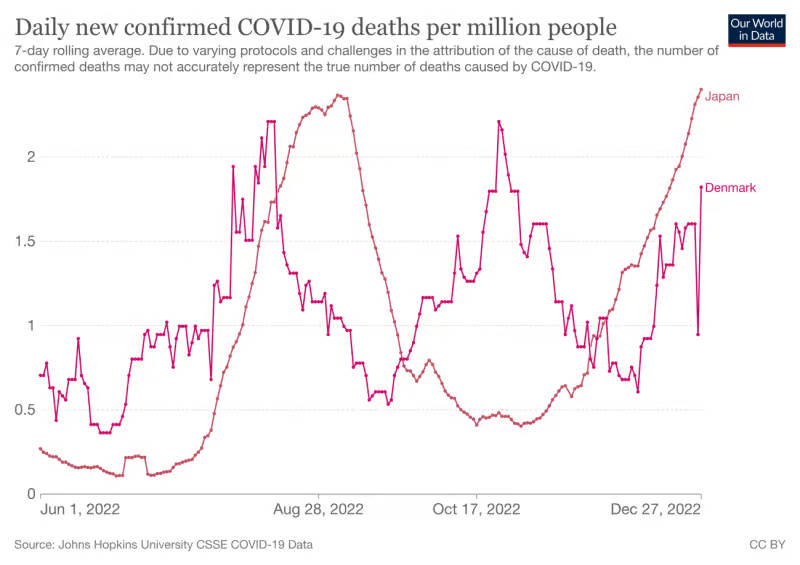
Japan isn’t alone. The graphic illustration of the ineffectiveness of Covid vaccines in preventing the infection and mortality tolls can be shown with several countries. All these charts (Figures 2–9) prove the pointlessness of vaccine certificates:
- In Japan, the total number of Covid deaths until 80 percent of the population was vaccinated on 9 December 2021 was 18,370. In little over one year since then, the death toll has climbed by another 37,858. That is, more than twice as many have died with Covid in the twelve months since 80 percent of people were fully vaccinated than in the 19 months until then.
- Israel’s vaccination drive hit 50 percent of the population on 28 March 2021, on which date its Covid death toll was 6,185. Another 5,838 Israelis had died with Covid by 28 December 2022, meaning nearly half the total Covid dead came after half the population was fully vaccinated. Israel and Palestine are one example of different vaccination rates among adjacent communities (Israelis high, Palestinians low) having little impact on their death rates.
- In the US too the 516,000 Covid deaths after reaching 50 percent double-vaccination coverage on 9 July 2021 represents 46 percent of all Covid deaths until 28 December 2022.
- Australia hit the 50 percent vaccination threshold on 11 October 2011, with the Covid death total being 1,461 on that date. The mortality toll was 16,964 on 28 December 2022. Thus 10.6 times as many Australians died with Covid in the 14 months since 50 percent were double-vaccinated as in 19 months until then.
- For what it’s worth, New Zealand’s experience has been even worse. Its Covid death toll as at 28 December was 2,331, 78 times higher than 30 at 50 percent vaccination mark, and 57 times higher than 41 at 70 percent vaccination.

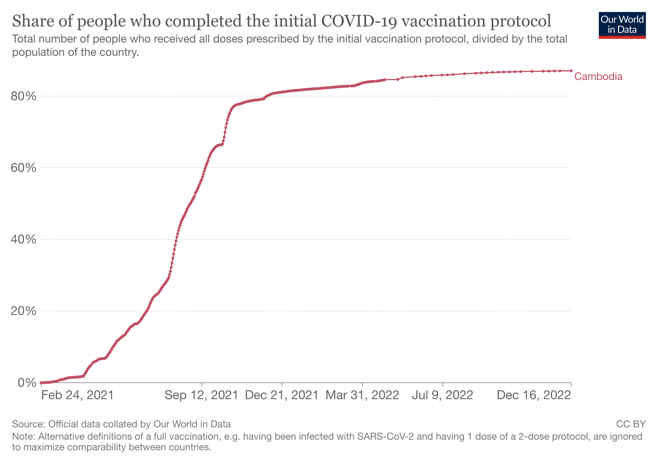
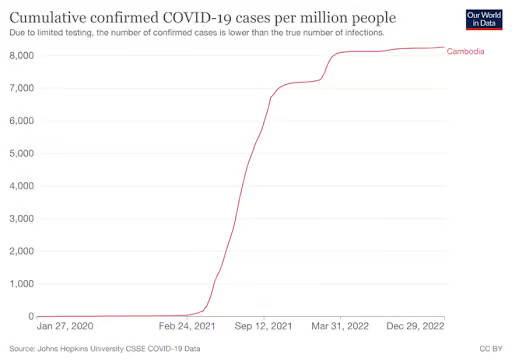
How anyone can look at the Covid vaccination and mortality metrics of New Zealand, Australia, and Japan and still hold fast to the ‘safe and effective’ vaccine narrative is beyond comprehension. Instead, one more initially plausible hypothesis is that the behaviour of the virus is Covid vaccine-invariant, and a second hypothesis is that the vaccine may actually be driving infections, serious illness and deaths by some mysterious mechanism not yet identified by scientists – although some studies are starting to point the way.
Earlier, Gibraltar, Cambodia, (Figure 5) and the Seychelles were examples of countries where Covid infections spiked in 2021 despite substantial vaccination in their populations.
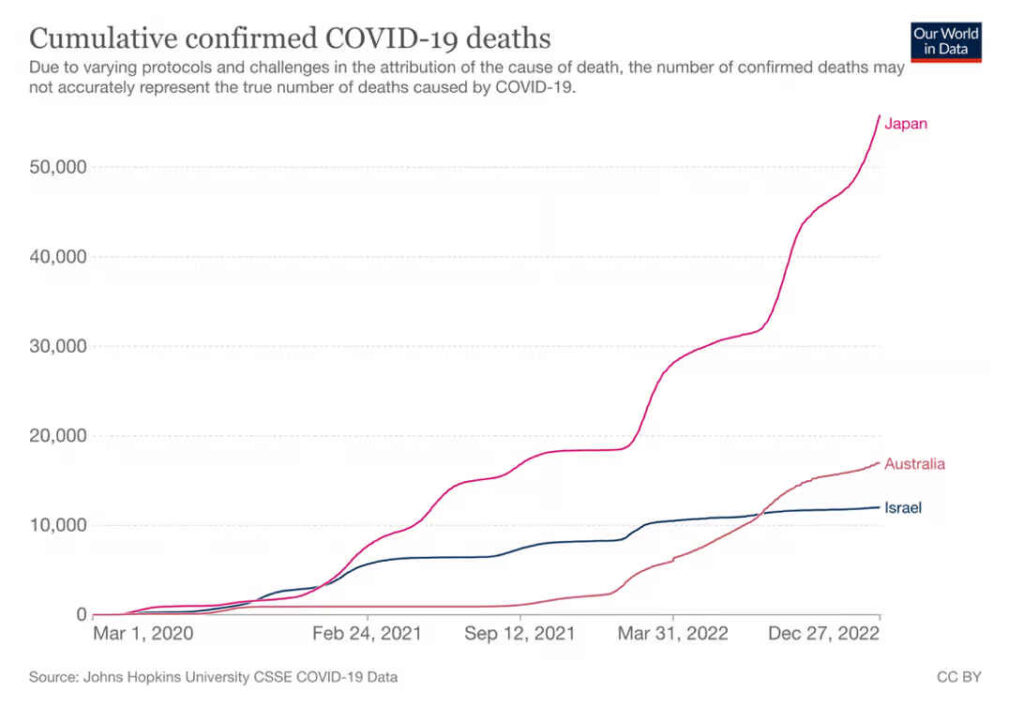
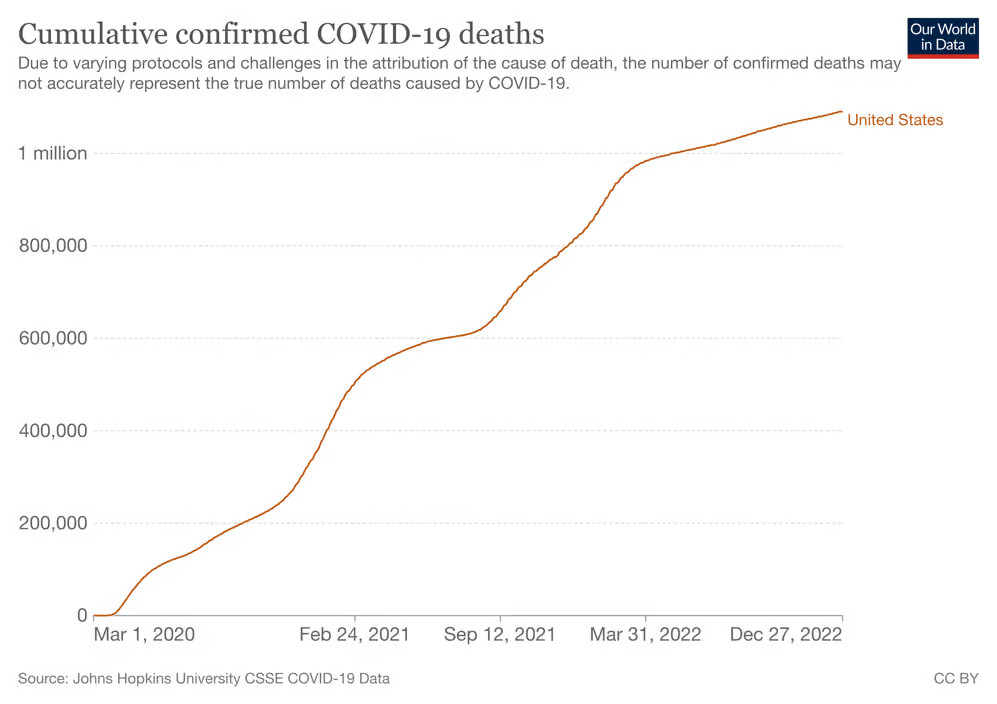
The weekly surveillance report from New South Wales (NSW) Health for the week of 11–17 December, published on 22 December, is the last one for the year. The next one will be published on 5 January but the reports will no longer include the vaccination status of people hospitalised, admitted to ICU or dead with Covid.
Until the week ending 21 May 2022, the reports lumped together the unvaccinated with those whose vaccination status was not known. Figures 8–9 therefore represent the entire data set for NSW Covid-related hospital and ICU admissions and deaths, from 22 May to 17 December 2022 inclusive, for which these statistics are available by vaccination status. It’s worth noting that 83 percent of the state’s total population was at least double-vaccinated, which accounted for 75.3 percent of Covid-related hospital admissions (slightly underrepresented) and 83.1 percent of deaths (almost exactly the same as population share).
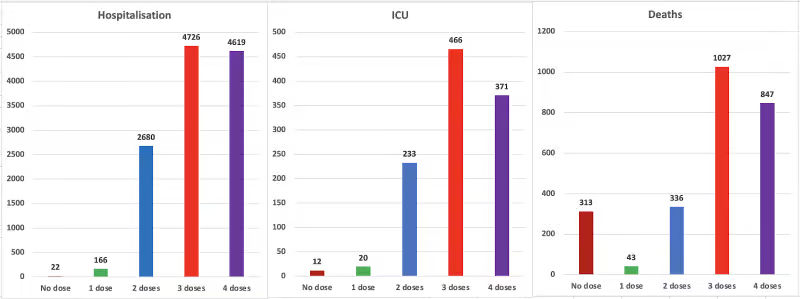
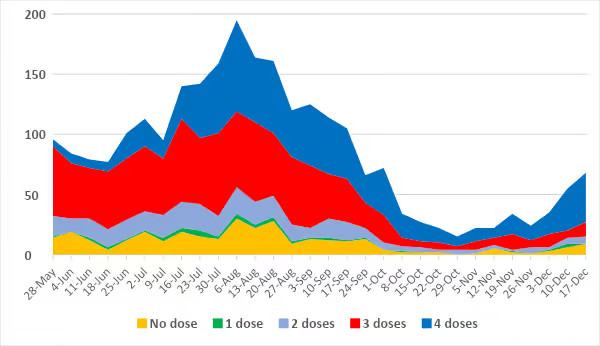
According to the federal Department of Health, by year’s end 96.0 percent of Australian adults (16+) were double-vaccinated, 72.4 percent had received at least three doses and 44.2 percent four doses. For NSW the corresponding figures were 95.8, 70.5 and 45.6 percent. With all due respect (or not) to the Australian health bureaucrats, it is impossible to spin Figures 8 and 9 as graphic evidence for the vaccines being effective.
A study out in December 2022 in preprint of employees of the Cleveland Clinic in Ohio from 12 September to 12 December found that effectiveness of the new bivalent Covid vaccine – authorised by the FDA on the basis of trial results from eight mice – was only 30 percent. The real shock was discovering that infection rates increase incrementally with each successive dose of a Covid vaccine.
The infection rates among those vaccinated with three or more doses was three times higher than among the unvaccinated. The authors said: ‘The association of increased risk of Covid-19 with higher numbers of prior vaccine doses in our study, was unexpected.’ Prior infection is relatively more effective against reinfection.
READ MORE: State Power and COVID Crimes – Part 1
READ MORE: State Power and COVID Crimes – Part 3
READ MORE: State Power and COVID Crimes – Part 4
READ MORE: State Power and COVID Crimes – Part 5
We all no the clot shots are unsafe.and if you don’t see that by now you must be brain dead.2023 is going to be a massive year for deaths be prepared.